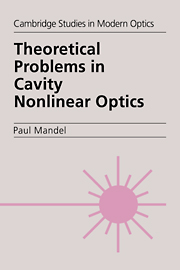Book contents
- Frontmatter
- Contents
- Introduction
- 1 Reduction of the Maxwell–Schrödinger equations
- 2 Parameter swept across a steady bifurcation I
- 3 Parameter swept across a steady bifurcation II
- 4 Optical bistability: Constant input
- 5 Optical bistability: Variable input
- 6 Multimode optical bistability
- 7 Free-running multimode lasers
- 8 Antiphase dynamics
- 9 Laser stability
- 10 Second harmonic generation
- 11 Saturable absorbers
- 12 Transverse effects in optical bistability
- Index
2 - Parameter swept across a steady bifurcation I
Published online by Cambridge University Press: 16 October 2009
- Frontmatter
- Contents
- Introduction
- 1 Reduction of the Maxwell–Schrödinger equations
- 2 Parameter swept across a steady bifurcation I
- 3 Parameter swept across a steady bifurcation II
- 4 Optical bistability: Constant input
- 5 Optical bistability: Variable input
- 6 Multimode optical bistability
- 7 Free-running multimode lasers
- 8 Antiphase dynamics
- 9 Laser stability
- 10 Second harmonic generation
- 11 Saturable absorbers
- 12 Transverse effects in optical bistability
- Index
Summary
Introduction
At the end of the previous chapter, we have seen that a characteristic of nonlinear systems is the presence of critical points, that is, values of the control parameter at which two solutions coincide. Note that at a critical point, more than two solutions can coexist and that the coexisting solutions need not be stationary: They can have any time dependence. In the next four chapters, though, we concentrate on the steady critical points at which two steady solutions coincide. If the solutions exist on both sides of the critical point, we call it a bifurcation point. Another type of critical point that will also draw much of our attention later is the limit point. However, the solutions exist on only one side of the critical point.
The main feature of critical points is that their presence is always signaled by the vanishing of the real part of at least one characteristic root in the stability analysis. For steady critical points, it is a real root that vanishes. In some cases, however, more than one root will vanish at criticality. Then one deals with degenerate critical points that may have richer properties. Physically, the absolute value of the real part of a characteristic root λ is a relaxation rate if Re(λ) < 0 and a divergence rate if Re(λ) > 0. Let λc be the root that vanishes at the critical point. The vanishing of a relaxation rate at criticality means the divergence of a relaxation time. Thus, an unconventional dynamics occurs in the domain surrounding the critical point that is characterized by critical slowing down.
Information
- Type
- Chapter
- Information
- Theoretical Problems in Cavity Nonlinear Optics , pp. 15 - 24Publisher: Cambridge University PressPrint publication year: 1997
